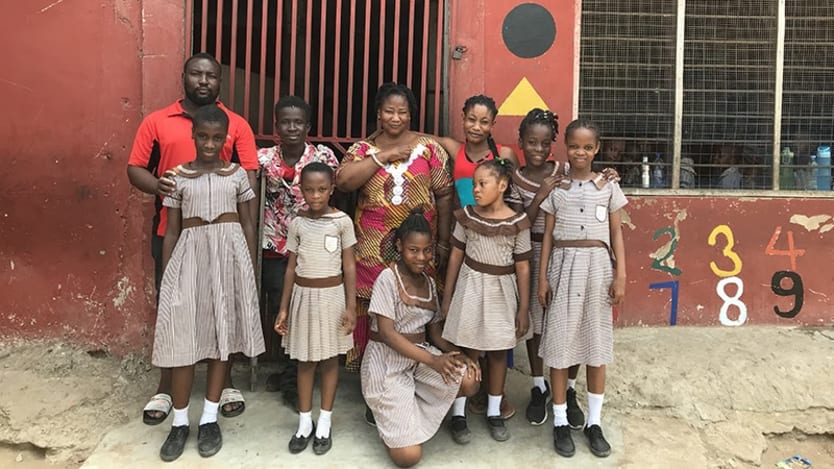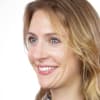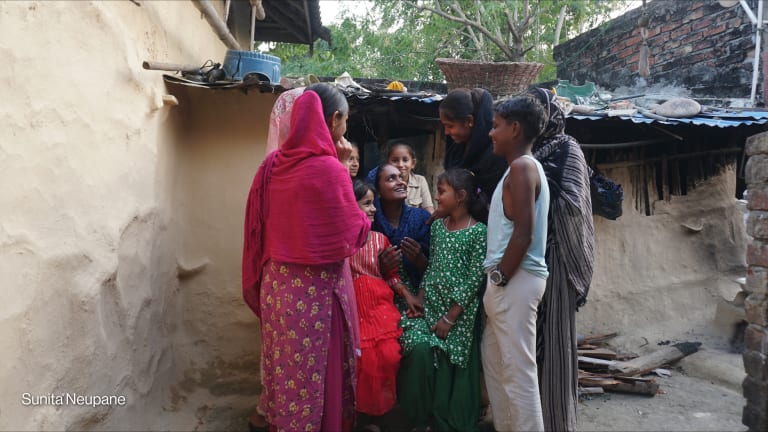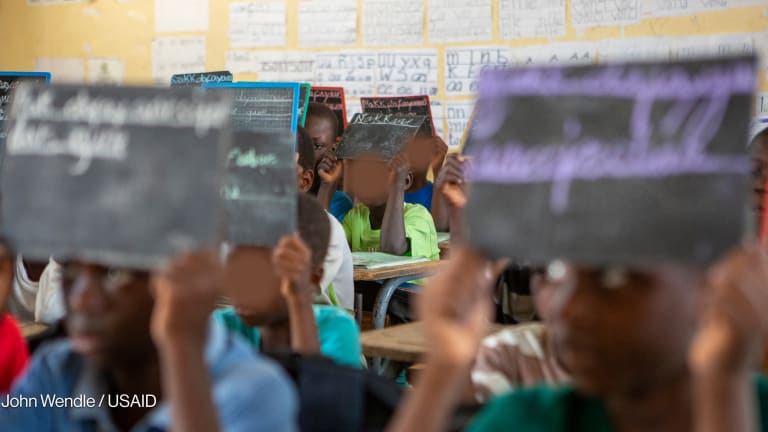
ACCRA, Ghana — When Selina Adablah, 54, started taking in local children — playing games, singing songs and feeding them for a few cedis a day while their parents were at work — she had no plans to open a school. But as word spread, she found herself with 10 regular kids and in need of more space. Now, 15 years later, she runs Divine Covenant Academy, a small school in one of Accra’s poorest slums, which currently has about 300 pupils, 11 teachers, and plans to expand further.
Low-cost private schools like Adablah’s — sometimes known as “mom n’ pop” schools — are increasingly common in low- and middle-income countries. They fill the gaps in education provision left by governments that are struggling to meet their commitments to free education, leaving millions of children either out of school or struggling to learn in underresourced and overcrowded classrooms.
More on the private school debate:
► Watchdog to investigate IFC support for Bridge private schools in Kenya
► EU resolution on private schools reignites the battle for global education
► Opinion: For-profit schools increase inequality. Here's why.
Charging far less than traditional private schools — Adablah charges 60 cedis, around $10, a term for tuition, with additional fees for lunch, books, and uniforms — low-cost schools tend to be run by local entrepreneurs or community members looking to fulfil a social need rather than turn a profit. Research suggests that most of them struggle to break even. A quarter of Adablah’s students are behind on their school fees at any one time, but she does not have the heart to send them home, she told Devex.
While many low-cost private schools are unregistered, making it difficult to estimate their reach, the Center for Global Development estimates that at least 120 million kids attend them. That means it is already a sizeable market with the potential to have a real impact on education in lower-income countries, CGD experts wrote in a recent blog.
Despite their growing significance, these schools are largely ignored by donors and governments reluctant to take on the challenge of regulating and supporting such a fragmented and diverse sector. Funders may also be put off by the heated debate over the role of private education in lower-income countries, with some arguing that public financing should only be used to support free, public education.
“Even if low-fee private schools are supported to improve their quality, they will continue to fuel inequality. Fees of any kind have been shown to exclude the poorest children,” Katie Malouf Bous, a senior policy adviser at Oxfam International, told Devex.
But for others, education systems need all the help they can get and small private schools, if better funded, could help deliver.
“There are hundreds of millions of these small mom n’ pop social enterprises throughout the entire developing world. The problem is the market is completely underresourced because those schools are ignored by governments … and every funder in the international development community,” said Irene Pritzker, founder and president at the IDP Foundation, one of the few foundations to work with the schools.
A mixed picture
According to World Bank data, more than 250 million kids in lower- and middle-income countries are already being privately educated, the majority of whom are likely to attend mom n’ pop schools, according to Lee Crawfurd, senior research associate at CGD.
But there is little data on the extent and nature of private schools, especially in Africa. Available evidence suggests that they offer little advantage in terms of quality, but being able to hire cheap, unqualified teachers — who are more likely to turn up and teach than their government counterparts because their jobs are on the line — means low-cost private schools are able to “do more with less,” according to Crawfurd.
For Malouf Bous, this is one reason why they should not get public funding. “Low-fee private schools keep costs down by paying extremely low wages to underqualified teachers and skimping on learning materials and school facilities,” she told Devex.
Others, such as the IDP Foundation, disagree, arguing that many proprietors want to hire better qualified teachers but need more funding to do so.
The issue comes back to a long-running debate about the role of private schools in lower-income countries, with groups including Oxfam campaigning against all forms of private education, while others — including major education donors such as the U.S. Agency for International Development — seeing a role for private provision when government education is falling short.
“These schools are often responding to demand from parents due to rapid population growth and urban migration, and often where there are no government schools.”
— Aashti Zaidi Hai, director, Global Schools ForumThe debate has escalated in recent years, centered on the growth of commercial school chains, some of which are accused of malpractices and of putting profit first.
But that controversy is spilling over to have a negative effect on mom n’ pop schools, according to Aashti Zaidi Hai, director at the Global Schools Forum, a network of non-state schools operating in lower-income countries.
“It is overwhelmingly small single-proprietor community schools — not chain schools — that are growing fastest in low- and middle-income countries,” she said. “These schools are often responding to demand from parents due to rapid population growth and urban migration, and often where there are no government schools. Critically, [they] require access to capital to expand and upgrade their services.”

A financially viable model
The IDP Foundation has been supporting mom n’ pop schools in Ghana for the past 11 years, after Pritzker realized that many local school owners were credit-worthy clients with other businesses but were unable to get loans to grow their schools.
“Nobody lends to these schools because they are deemed too risky because the parents … are desperately poor and so there are always cash flow issues,” she said.
The U.S.-based foundation started providing financial and management training to school proprietors to get them business ready to take out microloans for new classrooms, transport and supplies, and teachers.
The loans are managed by local microfinance partner Sinapi Aba, offered at below market rates and designed to meet the specific needs of school proprietors — for example, it does not chase repayments during school holidays.
In turn, Sinapi Aba borrows from the IDP Foundation at a concessional rate and in local currency — something rarely offered by donors — which enables them to take on clients who would otherwise be deemed too risky, Tony Fosu, Sinapi Aba’s CEO, told Devex.
The loan repayment rate is 94%. To date, the program has supported 655 schools with plans to add 450 more by 2023. While it targets schools serving low-income students, a little over 10% of the schools on its books are more expensive in order to spread the risk, Fosu said.
The Divine Covenant Academy has been part of the IDP program since 2014, during which time Adablah has taken out three loans worth 35,000 cedis, or $6,200, in total, and paying 23.5% interest. Though high, it is lower than commercial loans, which charge around 35%.
With the money, Adablah has been able to transform her school, building classrooms, an office, and toilets. Eventually she hopes to be able to take 1,000 students.
Why education stole the show at the Global Refugee Forum
The Global Refugee Forum set out with six focus areas around improving support for refugees — but the education focus area secured "unprecedented support," advocates say.
But while IDP tracks its impact on a school’s finances and size, it has little to show when it comes to its impact on learning. Only now is it taking a more deliberate approach to that, ramping up a program with Sesame Workshop — the nonprofit educational organization behind Sesame Street — to provide teacher training.
The program trains early-grade teachers in interactive and exploratory learning techniques, to help them move away from the traditional “chalk-and-talk” methods toward a more child-centered approach.
A three-year external evaluation is underway to assess the program’s impact on learning outcomes, with findings due in June.
Convincing others
It cost IDP Foundation $1.5 million to establish its low-cost schools program — $500,000 to create the loan portfolio and $1 million to develop the training — but since then it has become financially sustainable, Pritzker said, with the interest from Sinapi Aba covering the program expenses.
Having demonstrated it works, she wants other funders to replicate the model, and for governments to help by offering low-cost private schools subsidies and other support.
“We’ve shown that this is a very viable education financing mechanism. … It’s now up to governments and the international development community to see its value and potential,” she said.
However, funders have yet to “bite,” Pritzker admitted. She thinks the recent furore over chain schools has put some off — just last week, the World Bank Group said it would freeze all funding for for-profit schools.
There are other issues. While Pritzker says the program “hits the poorest schools,” a 2016 report found that IDP schools were unaffordable for the very poor — only 2% of students came from the poorest 25% of the population. Donors also struggle with the lack of quality data and evidence about the sector and may be reluctant to commit until more is known.
"With so little data, we just don’t know” about the efficacy and cost-effectiveness of the program’s impact on learning, CGD’s Crawfurd said.
But things could be set to change. In Ghana, USAID has signaled it wants to support the low-cost private school sector. Last year, it launched a $40 million request for proposals and conducted a study which found that parents prefer to send their children to these schools, and that they score better on numeracy and reading skills than public schools.
Sources close to Ghana’s education ministry said the report could encourage the government to work more with these schools, including by providing textbooks and access to land — things it is already meant to do, but often doesn’t, they said.
IDP’s Opuni thinks USAID’s interest could be the break they have been waiting for.
“We’ve shone a lot of light on [low-cost private schools]. … I’m very optimistic that ... the position of big funders will change. … Watch this space,” he said.








